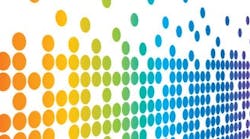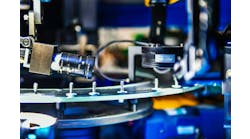"Most color sensors didn't do true color comparisons," says Jack Moermond, market manager for object detection and photoelectronics at Balluff. "The most-popular binary-output sensors took in percentages of red, green and blue, and output them to PLCs to indicate color presence or go/no-go conditions. Now, a lot of customers want to compare or sort different shades and textures. This capability used to be very costly. Also, color sensors are a lot easier to configure now."
The color sensor market hasn't performed especially well lately because vision systems have taken over some applications, according to Steve Nylund, CEO of Delta Computer Systems. However, both sensors and visions systems have suffered because they're often used in quality control projects that were put on the backburner during the recent recession.
"Our specialty is color sensors that can handle textured materials and surface variations, and so we've been stable because this is where lower-cost sensors can't perform as well," Nylund explains. "We also have a large 0.5 in.2 sensing area and a wide, diffuse lighting pattern that smoothes out our sensing process. Our sensors have been getting more sophisticated, and now we can teach them up to 15 colors with our ColorSense software. We gave the software the ability to more accurately show to the user what the sensor sees."
Michael Turner, product manager for photoelectric sensing at Pepperl+Fuchs, adds, "There's no middle-of-the-road color sensor. Either it's a basic type that's relatively low-cost with good performance but very limited in functionality, or it's manufactured by a color sensor specialist and it's extremely costly. I think there is room for innovation in the middle-of-the-road category."
Pepperl+Fuchs recently introduced a family of contrast sensors that is a special version of a color-mark sensor/contrast sensor, and incorporates IO-Link networking functions that can be used to establish an RGB benchmark, copy custom settings to multiple devices, and save changeover time.
"With the complexities of automotive interior assemblies (door panels, head liners, cockpits, seats, etc.), the possibility to install an incorrect component can be relatively high unless assembly is verified," says Victor Caneff, automotive business manager at Banner Engineering. "Our color sensor can verify that an installed component matches the color scheme of the interior design. Using a white LED light source, the sensor analyzes reflected light from the surface of the target. By comparing the red, green and blue content present in the reflected light, the sensor determines if the part matches a stored value from a known good sample programmed into its memory. Also, intensity thresholds can be established to detect if the part is the correct shade of the color."
Even in higher-tech vision systems, Cognex agrees, users want high resolution and to differentiate between shades, so they want 24-bit color processing software and tools to do it. "We came up with a color camera with 1,600x1,200-pixel resolution and Match Color and Extract Color tools in our Insight vision software to identify colors more accurately," says Narayan Subramaniam, principal product marketing manager for Cognex's vision systems.
Rick Bondy, product manager for registration solutions at Sick, says that besides teaching shades and setting tolerances, color sensors are aided by stronger LED light sources that allow longer sensing distances, and by its own 30x10 mm rectangular illumination area instead of the usual 18 mm circular light spots. Sick's sensors can identify and teach up to four colors.
"Many users are upset by vision systems that are costly, complex and hard to set up," Bondy says. "So, in the last three or four years, suppliers have been making them easier to integrate, maintain and apply."






